Previous Post Next Post
Monday, March 10th, 2008
Modern Native American Artists
Artistic Expression: Modern Perspectives of a
Modern People
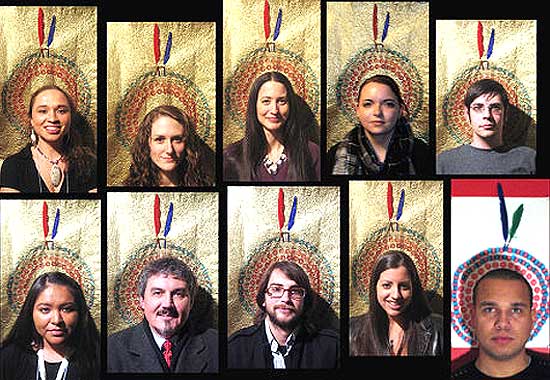
Dan Loudfoot, Everyone Wants To Be An Indian, participants, backdrop and photo document
A Native American Heritage Series Event
February 8-28, 2008
John Nickolas Brown Center
Brown University, Providence RI
by participating artist, Nayana Glazier

I experienced apprehension in the days leading up to the event. This came from the original reasons why Loudfoot, Echo-hawk and I had been planning the very same type of event previously. I wondered what the backgrounds were like for the other artists whom I was not familiar with. Did they have these same feelings? Did their work express the same ideas? Being of mixed blood would that affect their view of me or my work? These are all questions that I think all of the artists involved in this show probably thought in the days leading up to the reception.
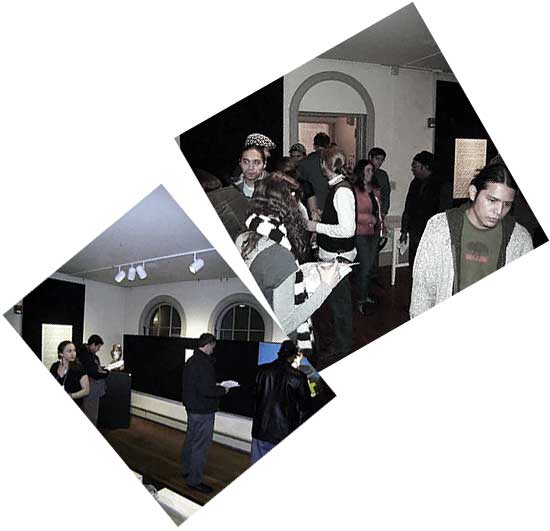
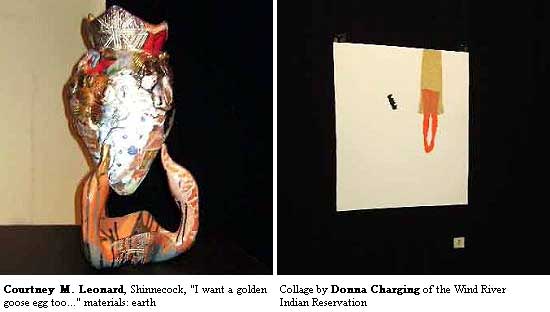
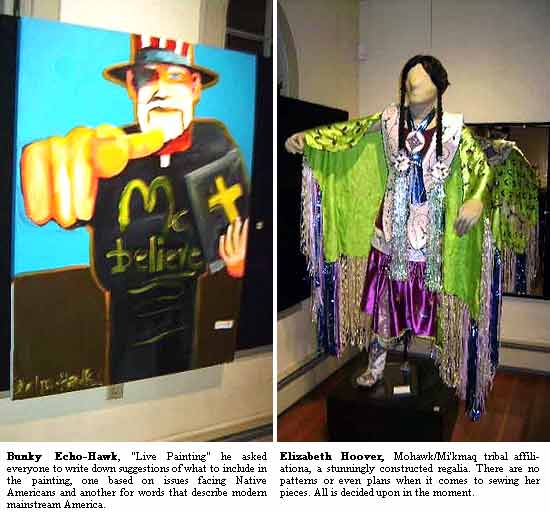
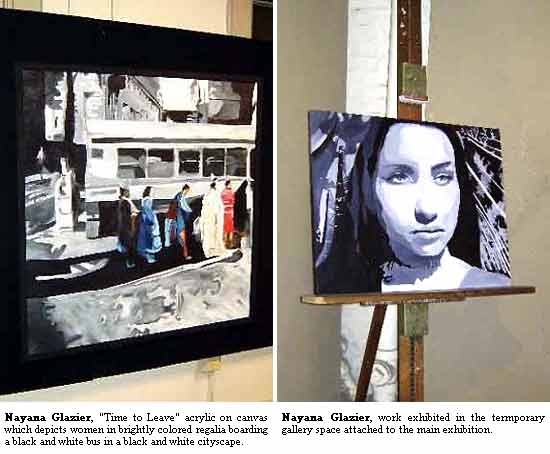
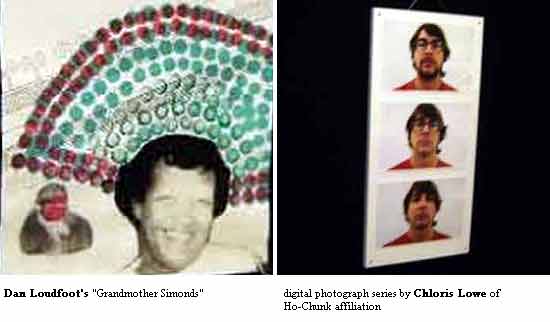
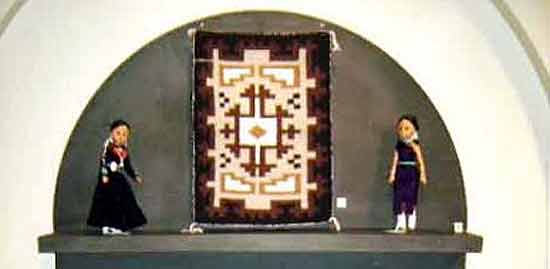
Winifred Bessie Jumbo, site specific placement of ritual objects
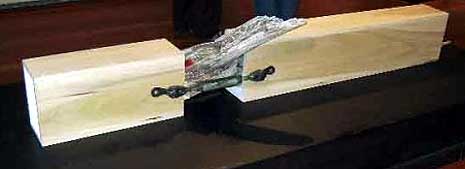
Chloris Lowe, object, wood, steel, bronze and fabric
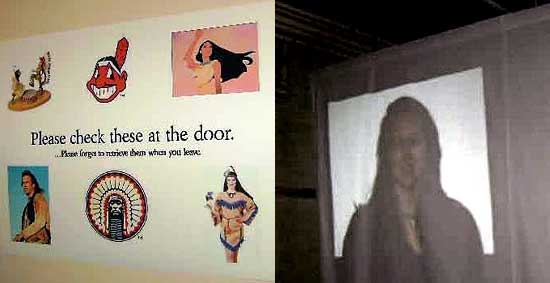
“Please check these at the door …Please forget to retrieve them when you leave”
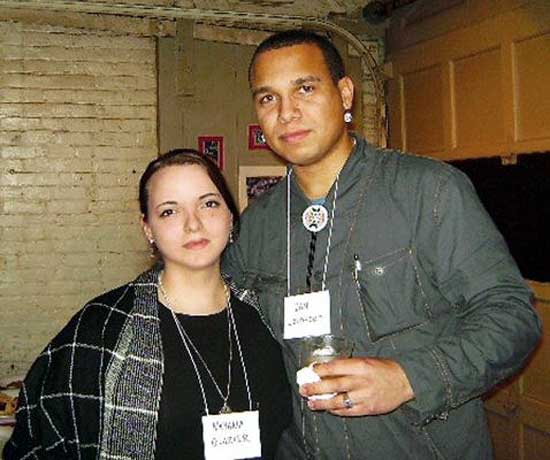
Nayana Glazier and Dan Loudfoot
Upon leaving to make the drive home I said goodbye to Dan Loudfoot, who I had only just met in person that night, we both expressed a desire to take this concept and the one we had begun before and have the show travel. We will now be looking for venues around the country where we can have this same sort of event.

Artistic Expression: Modern Perspectives of a
Modern People

Dan Loudfoot, Everyone Wants To Be An Indian, participants, backdrop and photo document
A Native American Heritage Series Event
February 8-28, 2008
John Nickolas Brown Center
Brown University, Providence RI
by participating artist, Nayana Glazier
Friday February 8th was a day that I was apprehensive would ever come. I also never imagined it would happen with out my hands-on involvement. But a little over a month previous I received an email from Mikel Brown co-programmers of Native Americans at Brown (NAB) I was surprised. She explained to me their plans for an exhibition at the John Nicholas Brown Center at Brown University.

I experienced apprehension in the days leading up to the event. This came from the original reasons why Loudfoot, Echo-hawk and I had been planning the very same type of event previously. I wondered what the backgrounds were like for the other artists whom I was not familiar with. Did they have these same feelings? Did their work express the same ideas? Being of mixed blood would that affect their view of me or my work? These are all questions that I think all of the artists involved in this show probably thought in the days leading up to the reception.

Then it came, reception day, large white building with pillars and a stonewall with gate. We found our way in through the carriage house to what resembled a small parlor converted into the style of gallery you would see in most higher end New England colleges. Almost a cliché considering the subject matter of the exhibition. After hanging coats I found my way into the gallery to explore the works. Armed with my name tag and the knowledge that others were looking at me the same as I was looking at them. “There is another artist, I wonder what work they did, I wonder if they know I am one of the other artists, I wonder what they truthfully think of this exhibition.”
Upon entering the space I was immediately greeted by the over all composition of the room. The work was positioned clockwise around the chamber surrounding a large sculptural piece in the center. Pieces were numbered with an accompanying booklet filled with the names, tribal affiliation, and explanation of their work. I immediately grabbed my packet and made my way around the room. The space was filling up with other artists doing the same as the time approached for the general public to arrive.

One, was a piece by Courtney M. Leonard, with the tribal affiliation of Shinnecock. Leonard is a grad student at RISD and presented a piece entitled “I want a golden goose egg too…” for which she listed the materials as “earth” Upon further exploration of the room I found she had a total of 3 pieces in the exhibit all of which had the same aesthetic and appeal to them. They resembled vessels and the first an egg with sculpted detailing and unique glazing. The thing that struck me most about them was the content of the imagery included on them. Stamps of strawberry shortcake and drawings of buildings adorn these traditional shapes as if to suggest the Americanization of her lifestyle and ideals. Almost caught between the two worlds of the traditional and modern. “Would this definition consider me as one (a traditional potter) if I admitted I began with play dough?” Leonard states in her explanation of her work. www.courtneymleonard.com
Two as a cut origami paper and Rives BFK collage by Donna Charging of the Wind River Indian Reservation. This piece alluded to more but through her explanation I was unable to see the full truth behind it. The figure out of cut paper was suspended from the top right with what appeared to be hair, or a “scaling” falling away to the left. The legs on the figure seemed lifeless and dangling and I could not help but wonder what it was specifically about. I am unable to ask the artist this however and am still left wondering. www.donnacharging.worldecho.com

Three was a piece by Bunky Echo-Hawk, The piece featured had been produced as a “Live Painting” at Brown’s previous event in which he had set up to paint and did so by the suggestions of those in the room at the time. He asked everyone to write down suggestions of what to include in the painting, one based on issues facing Native Americans and another for words that describes modern mainstream America. People threw up ideas such as “domestic violence”, “Identity”, “mascots” and “fast food”, “Immigration” and “Britney Spears”. Ultimately it ended as a piece with a blue sky, almost annoyingly happy blue, with an “uncle Sam wants you” post to a man with a top hat and preachers uniform with blood trickling from the corners of his mouth and the words “Mc. Believe” across his chest. The piece as a whole is dynamic and impactful. The story of its creation just as much a part of the piece as the finished product itself. For a full article on this project visit this Brown-Daily-Herald-Link or www.bunkyechohawk.com
Five was a stunningly constructed regalia by Elizabeth Hoover, Mohawk/Mi’kma q tribal affiliation. This piece held onto its tradition wile incorporating the colors and ideas of the modern generations. I spoke with Ms. Hoover about her method and reasoning behind her work and found that she works much as a painter or other artist would. There are no patterns or even plans when it comes to sewing her pieces. All is decided upon in the moment, the works that result are as individual and intriguing as any other art form.
Five was a stunningly constructed regalia by Elizabeth Hoover, Mohawk/Mi’kma q tribal affiliation. This piece held onto its tradition wile incorporating the colors and ideas of the modern generations. I spoke with Ms. Hoover about her method and reasoning behind her work and found that she works much as a painter or other artist would. There are no patterns or even plans when it comes to sewing her pieces. All is decided upon in the moment, the works that result are as individual and intriguing as any other art form.

Six was my piece, I had submitted “Time to Leave” a large acrylic on canvas which depicts women in brightly colored regalia boarding a black and white bus in a black and white cityscape. This piece was meant to represent the idea of being in a modern city and feeling out of place, remembering what was once there in its place. www.picturetrail.com/nayanag
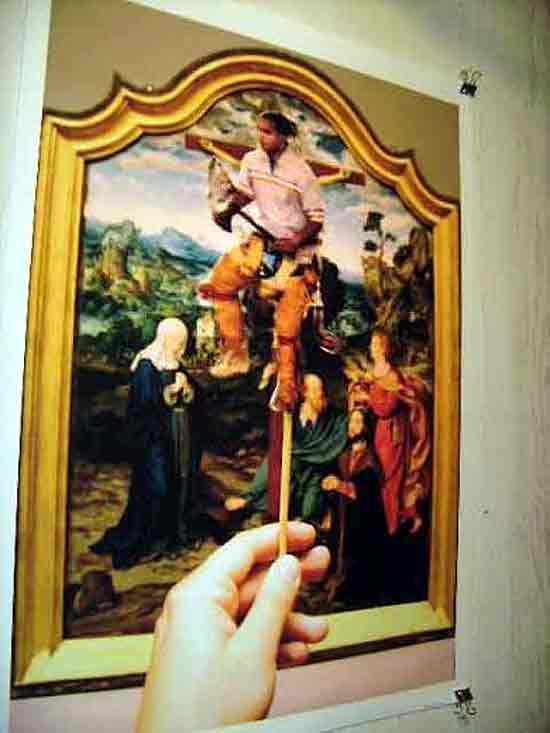
Dan Loudfoot, print enlargement with hand
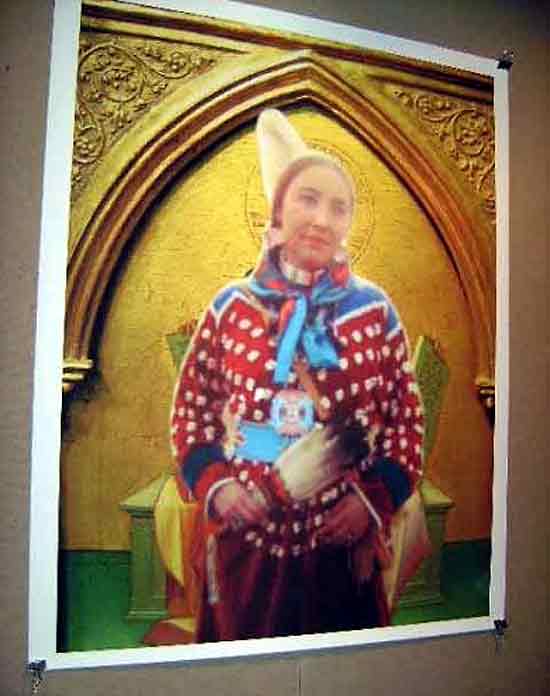
Dan Loudfoot, print enlargement

Dan Loudfoot, print enlargement with hand

Dan Loudfoot, print enlargement

Seven was Dan Loudfoot’s “Grandmother Simonds”, he also had piece Thirteen “Everyone wants to be an Indian” and several pieces in the temporary room where the refreshments were held. Both pieces incorporate the use of bingo paint blotters to create traditional designs around a concept. In “Grandmother Simonds” he chose to put an image of his grandmother with that of a stereotypical Indian doll incorporating the bingo paint to form an almost mary-esque halo around his grandmothers head. “Everyone wants to be Indian” is an interactive piece in which visitors to the show sit in a chair positioning themselves to have their heads in the center of a circle of bingo paint with feathers at the top. These images will comprise a book when the exhibition is complete. www.danloudfoot.com
Four, a digital photograph series by Chloris Lowe of Ho-Chunk affiliation. This piece struck me because of its honesty and provocative ideas on identity related to being Native American. His piece spoke to me as a mixed blood native. Its title “searching for 1/4″ said it all for me. The series of three digital photographs, close ups on his face with small alterations such as glasses on or off reminded me of the experience of looking in the mirror searching for identity in what is easily seen. His physical appearance did not directly lead me to think he was of native ancestry and that is what made this piece the most interesting for me. There is always this feeling of non-acceptance for being or not being enough native and he tackled that issue in a ‘head on’ method. lowespaceartplace.blogspot.com

Winifred Bessie Jumbo, site specific placement of ritual objects
Eight and Nine are two dolls dressed in the traditional fashion by Winifred Bessie Jumbo of Navajo affiliation. Each element of the dolls outerwear means something about them and tells a story of where her life will go. These dolls are strangely generic in appearance as dolls themselves, it is what Jumbo does to them that make them unique and speak to the combining of ancient ideas and new ways. Her work speaks softly in its statement but has a deeper meaning that seems just within sight.
(picture unavailable)
Eleven were digital photographs by Jamie Spears of the RI Wampanoag who displayed images of her mother, cousin and cousin’s daughter at powwows. The thing that intrigued me about this work was the presence of such modern objects as head set microphones in otherwise traditional imagery.

Chloris Lowe, object, wood, steel, bronze and fabric
Fourteen I almost did not see at all, which is strange considering it is the largest piece in the show and positioned in the very center of the room. I rounded the room and on my way out realized that there were two pieces remaining. The last I soon found just outside the doorway but this number fourteen I had almost not seen. But when my eye finally fixated on it the whole perception of the room changed and it became impossible to enter the room with out seeing it. The piece is by Chloris Lowe, the same person who did the photographs that I found so poignant. This sculpture incorporates wood, steel, bronze and fabric to make an intimidating but organic feeling structure resembling a box pulled open at the center to reveal the remaining elements. Lowe says this piece stems from ideas on the medicine bundle. The objects inside came from personal stories and experiences of Lowe’s.
(picture unavailable)
Fifteen is a digital image created in Adobe Photoshop by Donovan Pete of Navajo affiliation. Entitled “Withered” this piece incorporated elements of the modern and ideas on the traditional to form a graphically strong composition which makes us wonder about what might come next. Kind of a perfect ending for the whole event.

“Please check these at the door …Please forget to retrieve them when you leave”
On my way out I saw a sign at the door that I had missed on the way in asking us to leave our preconceived ideas on Native Americans at the door.
The turn out was fantastic for the space and the feeling in the room was an over all welcoming experience. Rather than the usual awkward interactions with other artists we found ourselves talking about our work and the ideas behind it. The overall feeling in the room was appreciation for the event-taking place. Each artist I spoke with expressed their experience of being surprised and excited that the topics handled in the show were being addressed and presented in such a public forum. Every person involved seemed to be genuinely excited and honored to be participating and have the opportunity to present these issues and ideas to the public.
Conversations on everything from art to history and pop culture were passed around as each of us found a small piece of the connectedness that so many of our works expressed the absence of.

Nayana Glazier and Dan Loudfoot
Upon leaving to make the drive home I said goodbye to Dan Loudfoot, who I had only just met in person that night, we both expressed a desire to take this concept and the one we had begun before and have the show travel. We will now be looking for venues around the country where we can have this same sort of event.

The perspectives of the artist on art are rarely altered, except when faced with something that achieves what they themselves have tried to achieve but could not. Then I think the artist must look at things differently. This show did that for me.
– Nayana